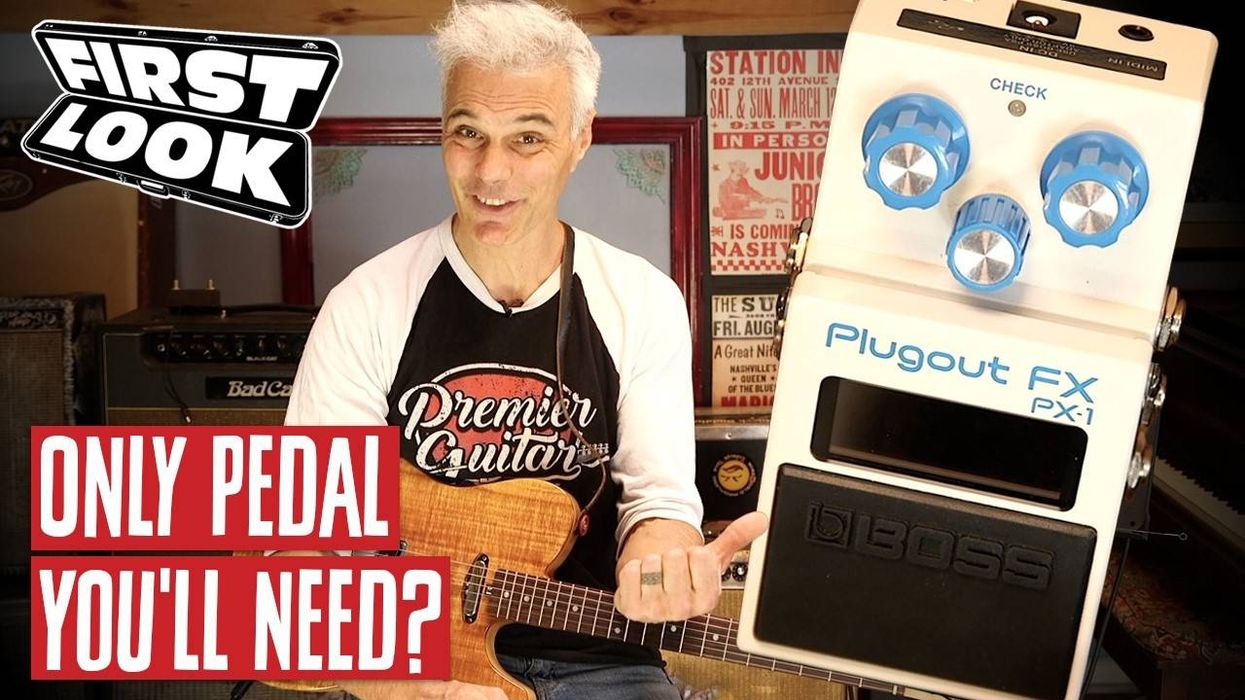In his excellent video Fuzz Detective, my former Premier Guitar colleague and pedal designer Joe Gore put forth the proposition that the Sola Sound Tone Bender MkII marked the birth of metal. Take Warm Audio’s Warm Bender for a spin and it’s easy to hear what he means. It’s nasty and it’s heavy—electrically awake with the high-mid buzz you associate with mid-’60s psych-punk, but supported with bottom-end ballast that can knock you flat (which may be where the metal bit comes in).
The Warm Bender dishes these sounds with ease and savage aplomb. Outwardly, it honors the original MkII—a good way to go given that the original Sola Sound unit is one the most stylish effects ever built. But the 3-transistor NOS 75 MkII is only one of the Warm Bender’s personalities. You can also switch to a 2-transistor NOS 76 circuit, aka the Tone Bender MkI. There’s also a silicon 3-transistor Tone Bender circuit, a twist explored by several modern boutique builders. Each of these three voices can be altered further by the crown-mounted sag switch, which starves the circuit of voltage, reducing power from 9 to 6 volts. From these three circuits, the Warm Bender conjures voices that are smooth, responsive, ragged, mean, mangled, clear, and positively fried.
The Compact Wedge Edge
Warm Audio, quite wisely, did not put the Warm Bender in an authentically, full-size Tone Bender enclosure, which would gobble a lot of floor space. But this smaller, approximately 2/3-scale version, complete with a Hammerite finish, looks nearly as hip. It’s sturdy, too. The footswitch and jacks are affixed directly to the substantial enclosure entirely apart from the independently mounted through-hole circuit board, which, for containing three circuits rather than one, is larger and more densely populated than the matchbox-sized circuit boards in a ’60s Tone Bender. Despite the more cramped quarters, there’s still room for a 9V battery if you choose to run it that way. Topside, there’s not much to the Warm Bender. There’s a chicken-head knob for output volume, another for gain, and a third that switches between the NOS 76, NOS 75, and silicon modes. Even the most boneheaded punk could figure this thing out.
A Fuzz Epic in Three Parts
Most Warm Bender customers will find their way to the pedal via MkII lust. If you arrive here by that route you won’t be disappointed. The Warm Bender’s NOS 75 setting delivers all the glam-y, proto-metal, heavy filth you could ask for. It sounded every bit as satisfying as my own favorite MkII clone save for a hint of extra compression that falls well within the bounds of normal vintage fuzz variation. My guess is that when you’re ripping through “Dazed and Confused” you won’t give a hoot.
“There’s more color and air in the NOS 76 mode.”
If the NOS 75 circuit suffers by comparison to anything, it’s the 2-transistor friend next door, the NOS 76. The lower-gain NOS 76 mode is, to my ears, the most appealing of the three. It’s the most dynamic in terms of touch response and guitar volume attenuation and delivers the clearest clean tones when you use either technique. There’s more color and air in the NOS 76 mode, too. Paired with a neck-position single-coil, it’s an excellent alternative for Hendrix and Eddie Hazel low-gain mellow fuzz that’s more like dirty overdrive. The silicon mode, meanwhile, lives on the modern borderlands of the ’60s-fuzz spectrum. It’s super-aggressive and focused, which can be really useful depending on the setting, but lo-fi, spitty, and weird when starved of voltage via the sag switch. It’s deviant-sounding stuff, but extends the Warm Bender’s performance envelope in useful ways, particularly if you hunt for unique fuzz tones in the studio.
There’s a widely accepted bit of wisdom that says most germanium fuzzes sound lousy unless you turn up everything all the way and use your guitar controls to tailor the tone. This is partly true, especially with a Fuzz Face. But in general, I respectfully disagree and present the Warm Bender as exhibit A in this defense. The gain and volume controls both have considerable range and fascinating shades of fuzz within that can still rise above the din of a raging band.
The Verdict
Some potential customers might balk at the notion of a $199 vintage-style fuzz made in China—no matter how cool it looks. But the Warm Bender looks and feels well made. The sound and tactile sensations in the three circuits are truly different enough to be three individual effects, and $199 for three fuzz pedals is a sweet deal—particularly when consolidated in a stompbox that looks this cool. There is a lot of variation in old Tone Benders, and how these takes on the circuits compare to your idea of true vintage Tone Bender sound will be subjective. But I heard the essence of both the MkI and MkII here very clearly and would have no qualms about using the Warm Bender in a session that called for an extra-authentic mid-’60s fuzz texture.


















